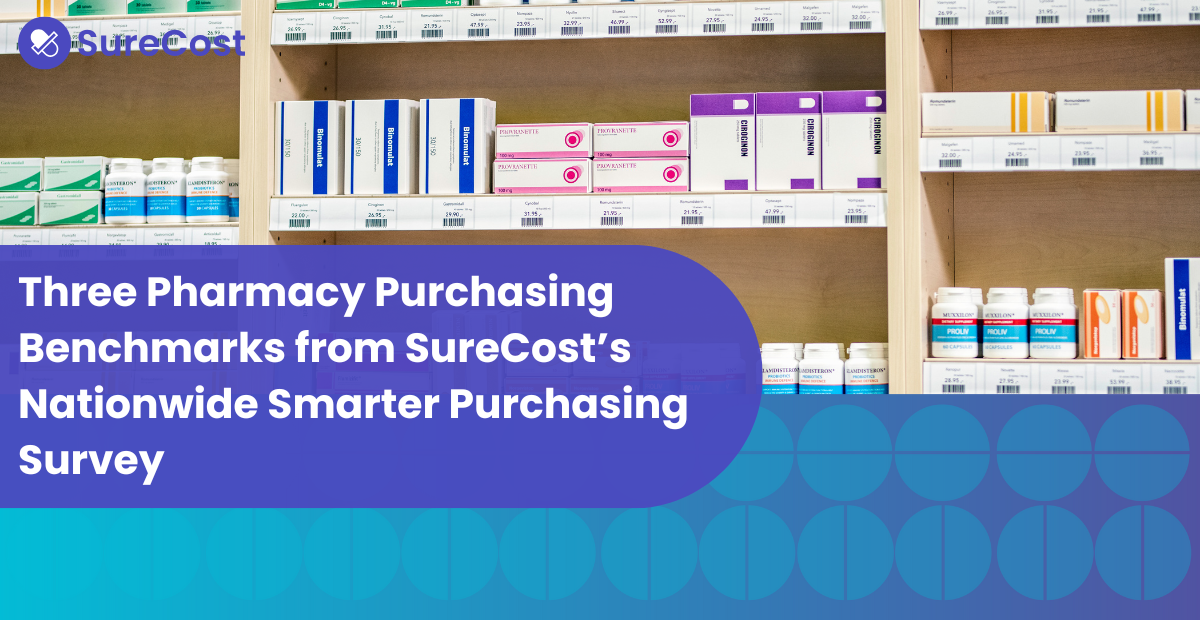Pharmacy professionals are all too familiar with drug shortages. Yet 2023 surprised the industry with a new record: 301 active drug shortages in the first quarter alone according to the American Society of Health-System Pharmacists (ASHP). That’s the highest figure since 2014.
It’s easy to see what this means. When pharmacies can’t purchase products, patients can’t get their medications. That disrupts the patient’s care, breaks down confidence in their pharmacy and drives them to seek other options. The impact on patients creates challenges for your business. Drug shortages could mean lost patients that leads to lower margins. Retail pharmacies, long-term care providers and acute care facilities all face these cascading difficulties.
It’s a new year with the same pain from drug shortages, which seem to only intensify as we move forward. Competitive pharmacies don’t just react; they develop proactive strategies and harness intelligent solutions to ensure continuity of patient care—without putting a strain on their staff or bottom line.
Roots of Drug Shortages
There’s no single cause of drug shortages, but supply chain disruptions are probably the most well-known issue. Many pharmacy products are manufactured overseas. Disruptions to global supply chains due to natural disasters or regional volatility may slow down or stop products from reaching the United States. A global crisis or conflict could potentially cut off access to essential medications.
Regulatory challenges like FDA closures and additional monitoring procedures compound these supply chain issues. The consolidation of the pharmaceutical industry has led to a smaller group of companies producing an even larger percentage of available products. That means fewer alternatives to find what you need.
Even if those products are reaching pharmacies, an industry staffing shortage means many of them can’t receive those products, effectively leading to a drug shortage on their shelves. Industry professionals also point out that market forces, such as margin pressure or deflation in product pricing, add further complications.
Pharmacy professionals are the last line of defense to prevent these risks, but we’re also the first to explain the impact to patients. It’s our responsibility to proactively manage these challenges.
Anticipate Potential Shortages
You can’t prevent drug shortages, but you can use information to see them coming. The FDA’s drug shortage database will supply updates and alerts that signal a potential shortage. The Associated System of Health Pharmacists (ASHP) provides a useful resource center for drug shortages. The Centers for Disease Control and Disease Prevention (CDC) has the most current information about vaccine shortages and delays.
Scot Rewerts, Director of Procurement at Thrifty White Pharmacy, offers some guidance on how to monitor the market for red flags:
If you notice products gradually slipping into backorder status, examine alternative manufacturers and their production locations. Monitoring the market is essential because shortages can arise unexpectedly, such as a pharmaceutical manufacturer filing for bankruptcy. Announcements of such events don’t always precede them.
Industry activity may also signal an upcoming shortage. For example, larger health systems and chain pharmacies may see shortages begin in locations nearer to a specific manufacturer. Don’t assume one or two pharmacies are the exception; they might be harbingers that the whole chain is preparing for a shortage. Secondary vendors are another potential “canary in the coal mine.” When a vendor offers a significant deal on an item based on having excess, it could mean they bought up the item because they anticipate increased demand.
This is not an exact science! A potential shortage is not the same as an actual shortage, so use your best judgment based on as much information as possible. Also, don’t just try to anticipate drug shortages; fortify your patient care and operations for when they actually happen.
Build Foundations to Mitigate Shortages
As we mentioned earlier, relying on a single source for all of your products is risky. On the other hand, the more you can diversify your vendors—while ensuring primary vendor compliance—the more options you’ll have in the event of a shortage. Back-up vendors empower you to be proactive (and not have to wait on the usual channels to supply products or respond to inquiries).
Also, make sure you have multiple vendor agreements in place that include specials and negotiated prices. And don’t put it off. Drug shortages are stressful enough. You don’t want to navigate them while also negotiating new contracts.
With an expanded purchasing portfolio, even in the face of shortages, you may be able to find enough of the product to meet your actual dispense patterns. That’s why accurate usage data is essential. You want to know (not estimate) your actual usage—at the correct prices—to lay the groundwork according to what your patients need.
Track usage history against your physical inventory. Order exactly what you need when you need it. That way, you’ll keep an up-to-date, “lean” inventory that meets patients’ needs while avoiding spoilage or excess stock. If you’re managing multiple locations, you’ll also want an efficient system for transferring stock.
Unfortunately, when it comes to preparing for drug shortages, many pharmacies have a false sense of security. That’s because they’re relying on one vendor’s catalog or a single purchaser’s knowledge. That doesn’t mean they have an accurate picture of their stock or the market. Plus, if that purchaser is out sick or the vendor hasn’t returned your calls, where does that leave you?
Harness Technology for Smarter Purchasing
Instead of intuition and manual processes, empower yourself with a single source of truth for your entire purchasing portfolio. Use technology to combine all of your vendor catalogs into one solution. A unified purchasing and inventory system enables experienced buyers and pharmacy operators to quickly identify and purchase the right option at the right price in the right quantity from all their sources while considering both vendors and packaging alternatives.
This helps you avoid scrambling in the face of drug shortages. For example, if you’re looking for a specific NDC and find low stock from your wholesaler, you can configure the system to show you the best alternative based on price, compliance and other selected variables.
Even if you’ve got ample stock, you don’t want to spend hours comparing separate catalogs and then uploading multiple purchase orders. Smarter purchasing solutions let you quickly place all your orders for all vendors through one interface. That includes any secondary vendors and service providers like GPOs.
With your purchasing and inventory data in one solution, you can leverage data to mitigate the impact of drug shortages. Track your usage, record your dispense volume and use flexible reports to see purchasing trends and make informed decisions for optimal inventory management. Program auto-reorders to keep requesting a product until it’s filled. With robust order history data, you can spot vendors who consistently fail to supply, which may prompt you to research other options.
Enhance Your Pharmacy in the Face of Multiple Challenges
Purchasing, inventory, rebates, compliance, receiving, DSCSA regulations: that’s a lot for a single team—let alone a single pharmacy manager. There’s a lot of software on the market for each facet of your pharmacy, but don’t add “managing multiple systems” to your list.
As the examples above show, smarter purchasing means not siloing your processes and data. It consolidates your work into one solution. We’ve discussed how uploading and tracking multiple purchase orders in different formats is both time-consuming and ultimately detrimental to savings. You can instead, submit one purchase order for all of your vendors. In addition to unifying all of your purchasing data, you can now standardize your goals and strategies across your pharmacy.
Having all of the data at your fingertips, analyzed based on your goals, allows you to standardize your strategy across multiple orders or pharmacy locations. You can also save time by automating repetitive purchasing and inventory management processes.
Finally, smarter purchasing should allow you to truly work smarter. That means integrating seamlessly with the rest of your pharmacy operations. If you’re already using a pharmacy management system, smarter purchasing lets you make purchasing decisions based on dispensing trends while automatically updating your “on-hand” count. Receiving goods, and paying invoices—when they’re correct—requires integration with your accounts payable department. When you’re ready to find a smarter purchasing solution, make sure it fits your needs and existing processes.
A Better New Year With Smarter Purchasing
By unifying purchasing and inventory and embracing data-driven decisions, pharmacies can mitigate the effects of drug shortages. But smarter purchasing technology is crucial for staying competitive in an increasingly complex industry.
Automated solutions analyze data, purchasing history and inventory levels to guide purchasing decisions while identifying savings opportunities and flagging errors. For example, when you receive products, are you always getting the right product at the correct quantity for the agreed-upon price?
The right technology streamlines purchasing, receiving, and reconciliation into a unified process. Seamless integration between purchasing, inventory, accounts payable and your pharmacy management systems means that no aspect of pharmacy operation stays in a silo.
Even as your pharmacy saves more, a smarter purchasing solution ensures you’re complying with vendor agreements, GPO contracts and rebate targets. It also checks that that purchasing sources are complying with their own terms. You’ll also gain tools to guarantee regulatory compliance. For example, you can configure your solution to comply with the latest DSCSA requirements.
Drug shortages are just one obstacle facing pharmacies in 2024. Proactive measures and strategic planning will keep your business competitive. More importantly, with the right solution, your patients know the medication they need is always on your shelves.




.png)



